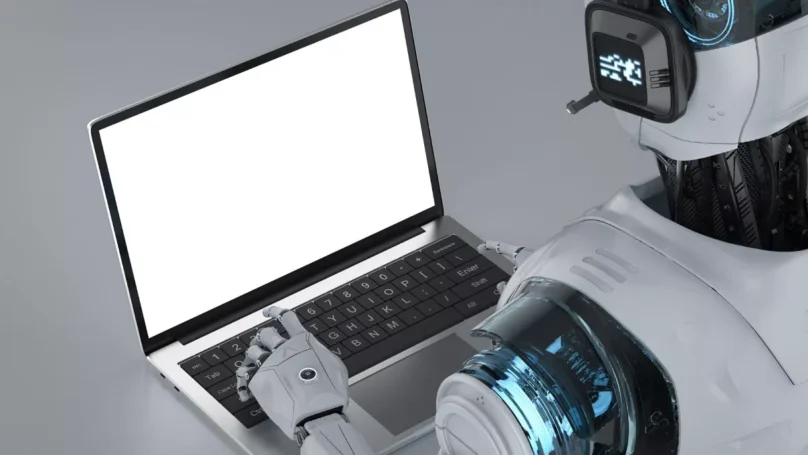As more AI-generated content enters everyday life, spotting differences between AI and human writing becomes essential. The accuracy of AI tools has improved, yet subtle clues often remain. Knowing the techniques to identify AI-driven content will help you better assess its quality and authenticity.
Whether for academic, business, or personal use, understanding these differences equips you with a clear advantage. Below, we break down the key factors to help you recognize if something was written by AI or a person.
Table of Contents
Key Points:
- Human content has variation in tone and structure.
- AI-generated text often repeats words and phrases.
- Flow and creativity differ between AI and human writing.
- Grammar and sentence structure provide clues.
Identifying AI Through Tools

There are tools available that analyze whether a text was written by AI. One such tool is ZeroGPT, which uses an AI checker to evaluate whether a piece of writing was generated by AI. It looks at patterns and consistency in the text to make an informed guess. Tools like these rely on a mix of algorithms to provide accurate results while keeping false positives low. Using a reliable tool helps verify if content was created by AI.
Writing Tone and Style Differences
Humans write with emotion, purpose, and individual style. Sentences can be short, long, or fragmented, but they serve the overall message. A person’s unique voice often comes through, reflecting a specific intention or goal. People insert nuance and subtle hints to evoke certain feelings.
AI-generated text, on the other hand, tends to follow patterns. It often remains neutral and lacks the varied structure common in human content. Sentences may feel robotic, with few or no deviations in tone. AI-generated content may also seem overly formal or consistent, unlike human writing, where tone can shift naturally based on context.
If you feel that the style feels too flat, or that there is no clear personality, chances are AI played a role.
Sentence Structure and Repetition

Humans vary sentence length and often create a rhythm with their words. Repetition is rare unless it serves a purpose. Phrases don’t echo each other unless there’s a reason behind them. People also experiment with grammar and punctuation to enhance readability and impact.
In contrast, AI-generated content often uses repetitive phrases. Words may repeat in ways that make it feel artificial. Sentence lengths tend to stay consistent, often leaning toward shorter structures. Grammar rules are followed strictly, without human creativity or flexibility.
If the writing feels repetitive or too rigid, AI might have generated it.
Creativity and Flow
Humans follow a creative process, drawing on experiences, knowledge, and personal insights. The writing will often include metaphors, analogies, or references that make sense only to a human audience. Ideas flow naturally, with thoughts linking smoothly, even when they shift between topics.
AI-generated content lacks deep creativity. It draws from pre-existing data, not personal experiences. While AI can produce clear content, the ideas often lack an emotional or intellectual depth. The transitions between paragraphs may also feel mechanical. If the flow of thoughts feels disconnected, AI could be behind it.
Context and Personal Input

When a human writes, the content reflects the personal touch of someone engaged with the topic. Even technical writing may include opinions, humor, or a casual remark. Humans can focus on details that matter most for a specific audience, adapting their tone and content based on context.
AI-generated text remains generalized. The details might feel off-target, or too broad to apply in a specific case. Personal input and engagement with the topic are absent. If you notice a lack of connection with the topic, it likely came from AI.
Language Usage
People use language in unique ways, depending on their background and experiences. Slang, cultural references, or idioms often appear in human writing. Word choice may vary depending on mood, with words often selected for specific emotional impact.
AI-generated text uses language in a more standardized way. It sticks to conventional word choices and avoids idiomatic phrases. Words may repeat unnecessarily, and sentences may lack the cultural or emotional nuance of human-written content.
Consistency in Writing Patterns

Human writers break up text with different patterns. You might find creative breaks, pauses for effect, or varying paragraph lengths. There is no strict adherence to any one style because the goal is to keep the reader engaged.
AI-generated text, on the other hand, follows the rules too closely. Paragraphs remain uniform. Transitions feel forced. Even if the content is factual, it lacks the human touch that comes through in varied writing patterns. Watch for overly structured or mechanical patterns—it’s often a sign of AI generation.
Grammar and Punctuation
Humans make minor grammar mistakes, especially when rushing or writing informally. However, intentional rule-breaking can make content feel more alive. A missing comma or fragmented sentence might emphasize a point or add to the narrative.
AI-generated text almost always follows strict grammar rules. Every sentence may seem correct but lacks the flexible creativity of human writing. If the grammar is flawless yet doesn’t feel natural, it could indicate AI involvement.
Depth of Content
Writers take the time to explain ideas fully, adding detail where needed. Context and personal knowledge shape the overall message, often going beyond surface-level facts.
AI-generated text, while informative, tends to remain on the surface. Facts are delivered plainly, but without much exploration. The result is content that feels less satisfying or less complete. If the writing provides little substance, AI might be responsible.
Purpose and Audience

A person writing for a specific audience tailors their content to that audience. They consider the reader’s knowledge level and needs. Humor, analogies, or examples may vary depending on who the text targets. Human writers adapt based on their understanding of the audience.
AI-generated text lacks that adaptability. It remains neutral and rarely addresses the needs of a specific group. The writing may feel distant, rather than directed toward any one group. If the writing fails to engage the audience, AI could be the reason.
Overall Cohesion
A human writer weaves ideas together naturally. Transitions feel seamless because there is a logic behind the connections between ideas. The writing reflects thought, care, and intention.
AI-generated content often lacks cohesion. Paragraphs may jump between ideas without clear connections. The flow feels disjointed, with little or no progression from one point to the next. If there is no clear line of thought connecting the sections, you may be looking at AI-generated text.
Use of Figures of Speech
Humans use figures of speech like metaphors, similes, and hyperbole to make their points clearer or more engaging. A well-placed analogy helps illustrate complex ideas or adds humor.
AI-generated text rarely uses these tools effectively. It might include a basic metaphor, but often lacks the subtlety or wit found in human writing. If the writing feels flat or too literal, AI might have created it.
Conclusion
Differentiating between AI and human writing comes down to examining several aspects of the text. Pay attention to tone, repetition, creativity, and overall flow. Watch for patterns and grammar rules followed too closely.
AI checkers can provide added certainty when you need to verify content origin. By honing your ability to detect differences, you can make better judgments about the authenticity of what you read.
Related Posts:
- AI vs. Human Writing - How to Tell Who (or What)…
- Blood vs. Crips ─ Exploring the Differences Between…
- AI Is Writing Books, Diagnosing Diseases, and Even…
- The Human Touch vs. Machine Efficiency: Can AI…
- Starting a Celebrity Blog: Writing Tips for Success…
- W2S Net Worth 2024 | Insights into His Influential…













